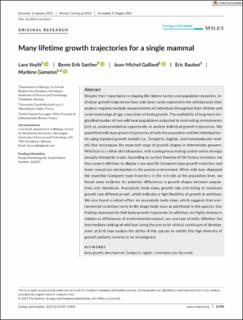| dc.contributor.author | Veylit, Lara | |
| dc.contributor.author | Sæther, Bernt-Erik | |
| dc.contributor.author | Gaillard, Jean-Michel | |
| dc.contributor.author | Baubet, Eric | |
| dc.contributor.author | Gamelon, Marlène | |
| dc.date.accessioned | 2022-12-05T08:54:09Z | |
| dc.date.available | 2022-12-05T08:54:09Z | |
| dc.date.created | 2021-10-14T10:30:44Z | |
| dc.date.issued | 2021 | |
| dc.identifier.citation | Ecology and Evolution. 2021, 11 14789-14804. | en_US |
| dc.identifier.issn | 2045-7758 | |
| dc.identifier.uri | https://hdl.handle.net/11250/3035780 | |
| dc.description.abstract | Despite their importance in shaping life history tactics and population dynamics, individual growth trajectories have only been rarely explored in the wild because their analysis requires multiple measurements of individuals throughout their lifetime and some knowledge of age, a key timer of body growth. The availability of long-term longitudinal studies of two wild boar populations subjected to contrasting environments (rich vs. poor) provided an opportunity to analyze individual growth trajectories. We quantified wild boar growth trajectories at both the population and the individual levels using standard growth models (i.e., Gompertz, logistic, and monomolecular models) that encompass the expected range of growth shapes in determinate growers. Wild boar is a rather altricial species, with a polygynous mating system and is strongly sexually dimorphic in size. According to current theories of life history evolution, we thus expect wild boar to display a sex-specific Gompertz type growth trajectory and lower sexual size dimorphism in the poorer environment. While wild boar displayed the expected Gompertz type trajectory in the rich site at the population level, we found some evidence for potential differences in growth shapes between populations and individuals. Asymptotic body mass, growth rate and timing of maximum growth rate differed as well, which indicates a high flexibility of growth in wild boar. We also found a cohort effect on asymptotic body mass, which suggests that environmental conditions early in life shape body mass at adulthood in this species. Our findings demonstrate that body growth trajectories in wild boar are highly diverse in relation to differences of environmental context, sex and year of birth. Whether the intermediate ranking of wild boar along the precocial–altricial continuum of development at birth may explain the ability of this species to exhibit this high diversity of growth patterns remains to be investigated. | en_US |
| dc.language.iso | eng | en_US |
| dc.publisher | John Wiley & Sons Ltd | en_US |
| dc.rights | Navngivelse 4.0 Internasjonal | * |
| dc.rights.uri | http://creativecommons.org/licenses/by/4.0/deed.no | * |
| dc.title | Many lifetime growth trajectories for a single mammal | en_US |
| dc.title.alternative | Many lifetime growth trajectories for a single mammal | en_US |
| dc.type | Peer reviewed | en_US |
| dc.type | Journal article | en_US |
| dc.description.version | publishedVersion | en_US |
| dc.source.pagenumber | 14789-14804 | en_US |
| dc.source.volume | 11 | en_US |
| dc.source.journal | Ecology and Evolution | en_US |
| dc.identifier.doi | 10.1002/ece3.8164 | |
| dc.identifier.cristin | 1945843 | |
| dc.relation.project | Norges forskningsråd: 223257 | en_US |
| cristin.ispublished | true | |
| cristin.fulltext | original | |
| cristin.qualitycode | 1 | |

